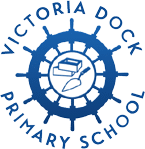

Geography – curriculum information
Intent
Our Geography provision at Victoria Dock Primary School aims to instil a sense of curiosity from the children about the world around them. The children work on acquiring necessary geographical skills and our geography provision aims to:
- Stimulate children’s interest in their surroundings and in the variety of human and physical conditions on Earth’s surface;
- Foster children’s sense of wonder at the beauty of the world around them;
- Help children to develop an informed concern about the quality of the environment and the future of the human habitat;
- Enhance children’s sense of responsibility for the care of Earth and its people.
- Increase knowledge of culture and teach respect and understanding of a multi-cultural world;
- Acquire and develop skills and confidence to ask their own geographical questions when undertaking enquiry, investigation, problem solving and decision-making.
The Geography curriculum at Victoria Dock Primary School is structured into four key areas of learning:
- Geographical skills and field work
- Human and Physical Geography
- Locational Knowledge
- Place Knowledge
In addition, to these areas, the school provides children opportunities to consider the importance of sustainability and builds in these opportunities under a fifth area of:
- Responsibility
To address these five areas, the Geography curriculum at Victoria Dock Primary School is taught through a series of key concepts.
Through the geography curriculum, pupils will develop an understanding of the following key concepts:
- Navigation: (interpreting a key, conventions of maps, map symbols, atlases, GIS, google maps, scale factor, reading and calculating from a scale, using compass points, the equator, the tropic lines, the poles, borders, countries and continents)
- Fieldwork: (Working collaboratively, planning investigations, collecting data, using instruments/specialist equipment, taking precise measurements, making observations, drawing conclusions)
- Population: (Dispersal, settlement patterns, infrastructure, migration)
- Economic activity: (Trade, land use, farming, wealth, poverty, imports and exports)
- Tectonic activity: (Volcanoes, earthquakes, tectonic plates, structure of the earth)
- Human features: (Transports, harbour, shops, towns, villages, community, places of worship)
- Physical features: (Water cycle, rainfall, mountains, hills, rivers, seas, oceans, tides, islands, tsunami)
- Natural resources: (Energy, minerals, food and water distribution)
- Sustainability: (Deforestation, climate change, renewable and non-renewable resources, sea level, food miles, industry, materials, globalisation)
- Climate and landscape: (Weather, rainfall, seasons, temperature, desert, polar, temperate, Mediterranean, arid, tropical, biomes, vegetation zones, tundra).
These subject specific concepts are explored through Geography units and provide lenses through which to consider different aspects of Geography. These concepts are revisited through different year groups as children move through the school to deepen their understanding and build their understanding progressively. Units are planned so that hierarchical knowledge is learnt at the appropriate points and further learning is cumulative each year.
Second order concepts are also developed across the curriculum to give children the knowledge and skills needed to communicate their understanding and relate their knowledge to real world examples.
Learning wherever possible is linked to the local area, however, the school understands the importance of providing a wider aspect of Geography too, to improve the children’s understanding of the world around them. In addition, every opportunity is given to promote the acquisition of language, vocabulary and to develop their speech and language skills.
In addition to the development of geographical knowledge, fieldwork is an integral element of the geography curriculum. Wherever possible, children are given real world opportunities to observe physical and human features, collect data and take measurements which can be used to make comparisons and draw conclusions.
At Victoria Dock Primary School we feel that it is important that the children gain an appreciation and understanding about their immediate community. We aim to instil within each child a sense of their own belonging within the world and how it effects their daily lives. All year groups begin the academic year with a carefully chosen local geographical/historical Hull study whereby they broaden their understanding about the importance their community plays.
Implementation
To deliver the key concepts, second order Geography concepts are taught and applied through each unit and build progressively as pupils move through the school. Pupils will also explore Geography through these second order concepts in all year groups promoting consistency across the school. A Geography progression document identifies the key knowledge and objectives required for each year group to teach all of the key concepts to the children. These objectives are ordered throughout the year carefully so that learning is embedded and deep.
Sequences of lessons are provided by the subject lead for Geography and are structured round a teaching sequence. At all times opportunities to develop vocabulary, written and oral expression and speech and language are promoted. Expected outcomes are provided for all staff.
The Geography curriculum makes full use of resources within the immediate and wider local area enabling children to develop a deep understanding of the geographical history of Hull. The coast, fishing ports, River Hull and local museums all form an important part in enriching the children’s understanding and broadening their knowledge.
All children have access to the Geography curriculum with work being tailored appropriately for children with SEND. Children will learn through similar activities, with final outcomes modified to suit all needs.
Our Geography curriculum is structured into four key areas of learning, which are consistent in each year group across the school. These include:
- Geographical skills and field work
- Human and physical geography
- Locational knowledge
- Place knowledge
Careful planning and consideration using termly pacing grids ensures that throughout their journey with us, the children access and experience the whole breadth of the National Curriculum in the most engaging, motivating and creative ways possible. Geography coverage throughout our school ensures that skills are progressive, and children have the opportunity to cover all progressive second order concepts by the time that they leave us in Year 6. Children build on previous learning ensuring that knowledge and understanding is embedded. Lesson objectives and plans are structured and sequenced so that final outcomes are secure, meaningful and prepare the children with skills and understanding necessary for their future lives. When teaching Geography, we provide opportunities to use a variety of information sources to enhance their learning and understanding of geographical concepts. These may include maps, statistics, pictures and geographical footage.
Geography in EYFS
The teaching of geography in the Foundation Stage is taught within the strand of “Understanding the World”. Understanding of the World is about how children get to know about other people, the place where they live and about all aspects of the environment.
Understanding the World is broken down into three aspects:
- People and Communities
- The World
- Technology
Our EYFS children are taught geography primarily through a balance of structured lessons and child-led play. Both approaches give opportunities for the children to make new discoveries on their own, with their peers and through quality first teaching.
By the end of EYFS children will begin to understand how they are part of their own locality which is part of a bigger world. They will learn about different people and communities and use speaking, listening and understanding to develop and explore these in greater detail linked to broad overarching topics.
Geography in Key Stage 1
By the end of Key Stage One, the children will have had the opportunity Use and make a range of geographical resources such as photos and maps to locate features in their locality and the world. The children will also develop an understanding of the continents and oceans that make up the rest of the world. They will understand the principle of directions and will become more adept at using locational and directional language. They will look at land use, climate and physical features of Great Britain and other locations in the world. The children will also begin to understand their own impact on the world.
Geography in Key Stage 2
By the end of Key Stage 2 the children will have developed the confidence to be able to compare the physical and human geography in their own locality to different locations around the world. They will be familiar with using maps, atlases and digital equipment to locate and describe different countries, continents and oceans around the world and will be able to demonstrate an understanding of using compass points and grid references to build their knowledge of the United Kingdom and the wider world. They will conduct simple fieldwork to exemplify common geographical processes and develop an understanding of map work such that these features can be examined and identified in a wider context. Children will gain knowledge of the impact of humans on the landscape and recognise the impact of themselves and that of nature in shaping the world in which they live.
Geography at Victoria Dock Primary School is delivered using a variety of teaching and learning styles in order to ensure that all children of all abilities and backgrounds have an equal opportunity to achieve and succeed in the subject. Where required, for SEND children, activities and teaching methods are tailored and modified to suit all needs.
Impact
The impact of learning is measured against the key concepts and key objectives within sequences of learning and is a measure of how much knowledge has been acquired. This may be through use of quick quiz assessments or longer written or oral outcomes to demonstrate understanding.
Assessment is stored using the Integris assessment system, which provides a clear overview for the subject lead of standards across the school.
Regular monitoring of work and pupil voice is used to moderate judgements which are made, and where learning is not secure, additional learning takes place to address this.
Further information
“The support and feedback offered through this difficult time has been fantastic.”
“The staff are really working hard to do their best for the children.”
“I moved here especially for this school and I am still very happy with my choice.”
“My child feels safe and happy.”
“You have gone above and beyond to ensure my children have everything they need and more.”
“You have gone above and beyond to ensure my children have everything they need and more.”
“I am happy with the school and the way is performs. My child appears to be happy and thriving and that is what is important.”
“I’m really pleased with ‘Victoria Dock’. Pleased we have made this choice..”
“What a fantastic online learning system the school has in place.”